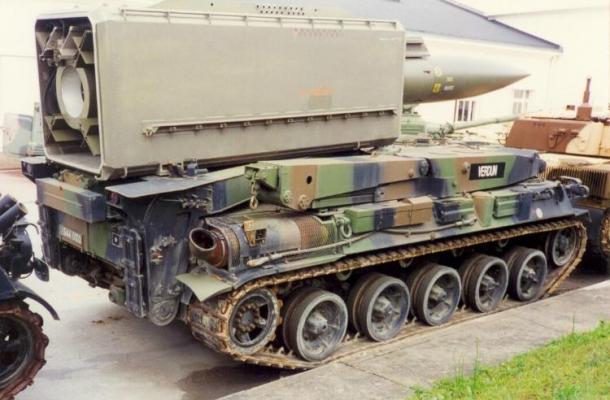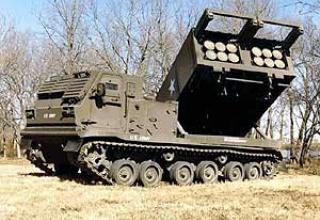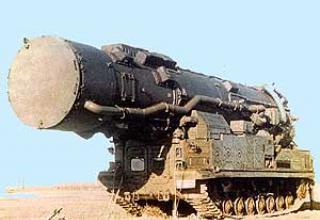"Pluton" is a French mobile short-range missile system with a monoblock-headed missile. The development of the complex was initiated by Aerospatiale, Space and Strategic Systems Division. "Les Mureaux" in 1960. Adopted into service by the French armed forces in 1974. The complex is mounted on a mobile launcher based on the chassis of the AMX-30 tank.
The complex was a means of supporting army corps and divisions and was intended to strike enemy troops and equipment in areas of concentration, missile launch positions and firing positions of artillery, control and communications centers.
The missile could be equipped with a conventional or nuclear warhead (BC). In the latter case, the plutonium bomb AN-52 was used. The AN-52 was tested on 2 July 1966 and was the first French "tactical" nuclear weapon.
Since 1974, 30 launchers have been put into operation with missiles of different FM. The missile systems were shelved, each with three firing batteries and a logistics battery.
The complex was gradually withdrawn from the French armed forces in 1993.
Composition:
There were two versions of the AN-52 ammunition with a capacity of 15 and 25 Kt (of the 80-100 manufactured AN-52 2/3 had a reduced capacity). The mass of the AN-52, which looked like a suspended fuel tank, was 455 kg, 4.2 m long, 0.6 m in diameter and 0.8 m in plumage. The bomb had a braking parachute, the standard blast height was 150 m.
The "Pluton" rocket (see diagram) was equipped with a solid fuel engine with an unregulated nozzle and had two modes of operation. The first mode of operation of the propulsion system takes place at launch with acceleration up to 10g. The second (marching) mode of operation of the engine provides speed up to 1100 m/s at the end of the active section.
The rocket control system is of inertial, simplified type. The control unit includes a gyroscope to determine the current speed and position of the missile in space, as well as an analogue counting and solving device. The executive device of the control system is the aerodynamic rudders at the ends of the cross-shaped stabilizer planes.
To launch the missile it was necessary to transfer information about the target to the control system of the complex. This was done using the C-20 unmanned aerial vehicle. Preparation for launch took 10-15 minutes. When approaching the target, a command was issued to blow up the combat unit.
The missile and the combat unit were transported separately in containers on conventional army vehicles. In the containers, the missile and the combat unit were placed on special spoons with shock absorbers. The containers were hermetically sealed and had climate control devices. The missile in the container was placed by crane on the PU frame and transported in this form. In the launch area, a combat unit is docked to the missile. After the launch, the container is removed from under the missile and can be reused later.
The launcher has a hydraulically operated device for installing a guide to the launch position, a computer-based computing system and the necessary equipment for prelaunch missile preparation. The equipment also includes communication, navigation, top linking and orientation equipment, power supply and life support equipment.
The fire battery consisted of a mobile command and control room, two fire platoons, a reconnaissance platoon and a top-guard. The firing platoon included a launcher and an AMX-10 infantry fighting vehicle designed for direct protection.
Characteristics:
| Length, m | 7.64 |
| Diameter, m | 0.65 |
| Weight, kg | 2423 |
| HR view | Monoblock |
| Fighting unit | Normal or nuclear 15/25 кТ AN-52 |
| Motor type | RDDT |
| Control System | Inertial |
| Range of fire, km | 120 |
| Firing accuracy (CWO), km | 0,15 |
Testing:
Flight tests of RSD-10 missiles began in September 1974 at the Kapustin Yar proving ground. In 1977, immediately after the complex was adopted for service by the USSR Strategic Missile Forces, its deployment began. The first missile regiment with the Pioneer complex went on combat duty on August 30, 1976 (Petrikov district, Gomel region commander A.G. Doronin). Mass deployment of the "Pioneer" complex began in 1978 in the position areas previously occupied by obsolete complexes with missiles R-16. Each missile regiment consisted of 6-9 self-propelled PU, provided with individual protective structures.
According to American data, the largest number of deployed launchers was 441 in 1986. According to the Soviet official data given in the Memorandum of Agreement on the Establishment of Initial Data in connection with the treaty between the USSR and the United States on the elimination of medium- and shorter-range missiles, as of November 1, 1987 in the USSR was deployed 405 RSD-10 missiles, another 245 ballistic missiles were in storage.
During the 15 years of operation, there have been no missile failures or accidents. During testing, operation and liquidation 190 missiles were fired. All the launches were successful. At the same time, the probability of hitting the target left 98%.
Sources:
- Суриков Б.Т. "Боевое применение ракет сухопутных войск" 1997 год.
- Military Analysis Network






